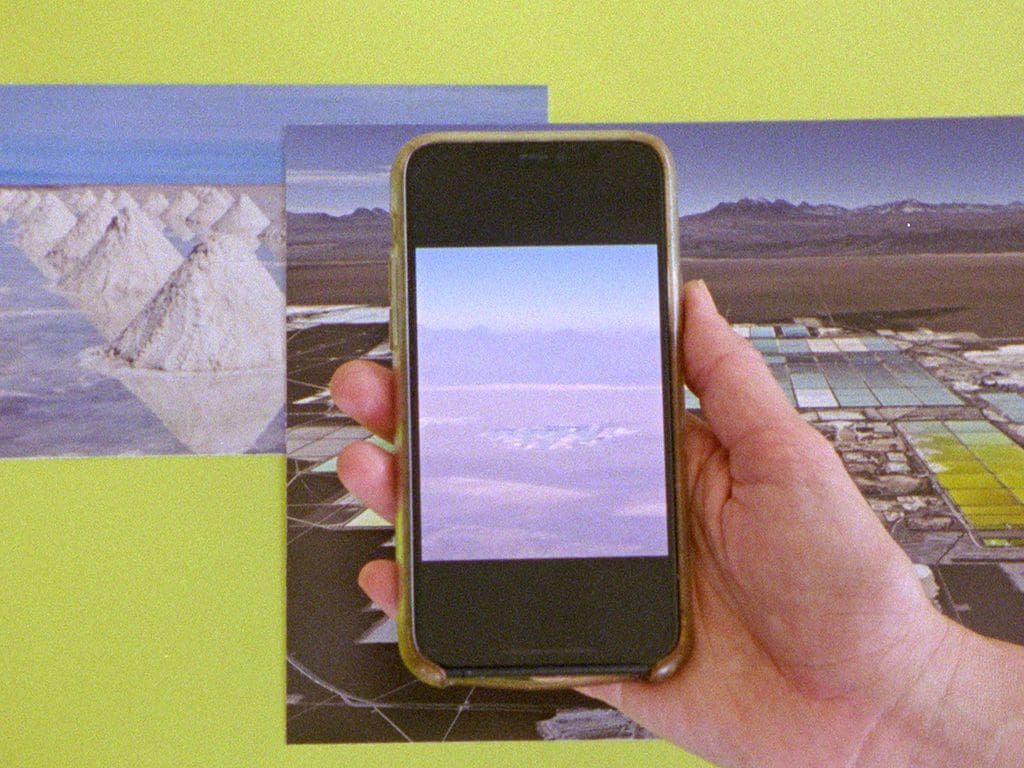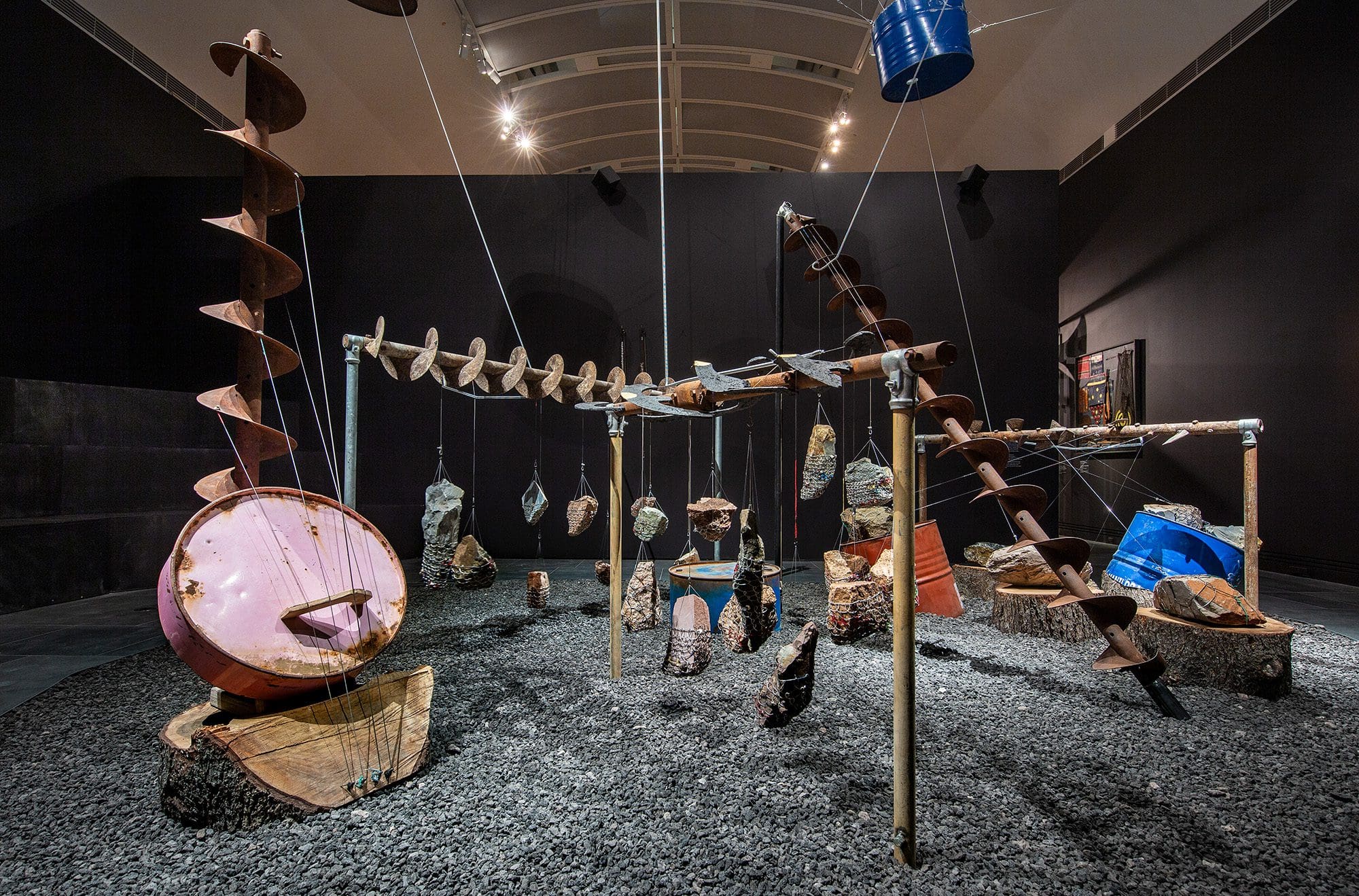
Piercing the veil
A new exhibition at Buxton Contemporary finds a rich complexity in the shadowy terrain between life and death.

Haines & Hinterding, Encounter with the Halo Field, 2009-2015, still from single-channel video, sound. Commissioned in 2009 by the Australian Network for Art and Technology and Art Monthly Australia with support from the Australia Council for the Arts. Reshot for High Definition in 2015. Courtesy the artist and Sarah Cottier Gallery, Sydney. Photo: the artists.

Elise Rasmussen, In the Valley of the Moon, 2022, still from 16mm film transferred to 4K, colour, 4 channel sound, 4:3. Courtesy the artist, Los Angeles, USA.

Jack Green, Desecrating the Rainbow Serpent, 2014, acrylic on canvas. Donated, 2022. Collection of Australian National University. Courtesy the artist and The Australian National University Art Collection, Canberra.

Diane Borsato, Gems and Minerals, 2018, still from colour video with sound and captions. Courtesy the artist, Toronto, Canada.

Eglé Budvytytè, Songs from the compost: mutating bodies, imploding stars, 2020, still from 4k video, colour and sound. Courtesy the artist, Amsterdam, The Netherlands.
Green energy promises a decarbonised future, beyond the burning of fossil fuels. Yet some prevailing technology can do harm, too. Consider, for instance, the extraction of lithium to power batteries in a world hungry for solar panels, electric vehicles, and mobile phones.
One ton of lithium can require two million litres of water, in a process of burning off until only the mineral is left. Much of the material is extracted from the “lithium triangle” in Argentina, Bolivia and Chile, often at the expense of Indigenous communities left with contaminated soil, biodiversity loss, river salinity and toxic waste.
Canadian-born, Los Angeles-based artist Elise Rasmussen says her work in the Valley of the Moon, a 16-millimetre film transferred to 4K video, examines what is “gained and lost in the name of technological progress”, focusing on Chile’s Atacama Desert, where copper, lithium and rare-earth mineral mining has “taken an environmental toll on an already fragile ecosystem”.
The film, created in 2022, will feature alongside work by more than 20 artists in We Are Electric: Extraction, Extinction and Post-Carbon Futures at the University of Queensland Art Museum, and it includes scenes of lithium mining in Atacama and of Elon Musk’s Tesla Gigafactory, a lithium-ion battery and electric vehicle component factory in Nevada in the United States.
Rasmussen’s film is “a really incredible work that problematises green energy futures, thinking through how potentially we’re reproducing extractive, environmentally desecrating actions”, says curator Anna Briers. “It binds together these two sites [the lithium mine and Musk’s factory] in a really interesting way. It’s the tension between ecological care and economic growth.”
In the wider exhibition, energy is portrayed in many forms, from the cellular level within bodies to the bigger picture connecting humans. Blue Mountains-based collaborators David Haines and Joyce Hinterding are exhibiting their video Encounter with the Halo Field, 2009-2015. It makes visible the sea of electromagnetic waves that surround us, resulting in a choreographed series of movements with fluorescent tubes.
Further on, a large-scale immersive installation, newly commissioned from Sydney-based artist Michaela Gleave, will take data from geomagnetic listening stations, “sonifying” that data to allow audiences to “listen to the energy of the earth in real time”. Viewers will watch a curved, sevenmetre screen while reclining on plush, hand-dyed, magma-shaped beanbags. Briers says the aim is to speak to “sympathetic vibrations, being in tune with planetary energies”.

Works by Indigenous artists Megan Cope, Jack Green and the late Mavis Ngallametta advocate the importance of Indigenous land management in a decarbonised, post petro-capitalist future. A painting by Ngallametta, a Kugu-Muman/Kugu-Uwanh woman, for instance, references backburning and rebirth after bushfire.
Quandamooka woman Cope’s installation Untitled (Death Song), commissioned for the 2020 Adelaide Biennial, responds to sand mining on Minjerribah (North Stradebroke Island) and copper and uranium mining at Olympic Dam, north-west of Adelaide, as well as extinction narratives. Made of violin, double bass and cello strings tautly woven around blasted rocks and disused oil drums, the work is played by musicians to mimic the ground-dwelling, bush-stone curlew bird, whose cry is a harbinger of death on Minjerribah.
Meanwhile Green, a senior Garrwa man from the southwestern gulf of Carpenteria, paints about fracking in the Northern Territory, advocating for the return of Indigenous custodianship of Country. “His work has actually been used in real-world contexts in legal settings, as evidence of environmental and cultural desecration of country,” says Briers.
In addition, The Institute of Queer Ecology, an academic and artistic United States-based collective that theorises queer utopian futures, is presenting a three-part video work, taking as its departure point the metabolism of a caterpillar and calling for “radical transformation” through the metaphor of a butterfly. Their goal is to destabilise the presumption of human superiority over nature.
Can art play a persuasive role in the adoption of greener technology—and is art used in the service of protest still art? “No one wants to instrumentalise art, because that wouldn’t make very good art,” says Briers, who believes artists nonetheless have a particular role in provoking discussion. “The Art Museum is a forum for conversation and critical thinking, and situated in a university context, that affords us access to really important research and discourses.”
One such study is the Net Zero Australia project (NZAu), a collaborative partnership launched in 2021 between the University of Melbourne, University of Queensland, Princeton University and management consultancy Nous Group, which will present the costs and benefits of five pathways to net-zero emissions by 2050. Overseen by a steering committee chaired by Australia’s former chief scientist Professor Robin Batterham, the study is funded by various energy companies.
“Part of what the museum can do is bring these conversations into the museum and entangle them with the artistic works,” says Briers, “but obviously still maintain the integrity of those works.”
We Are Electric: Extraction, Extinction and Post-Carbon Futures
University of Queensland Art Museum (Brisbane QLD)
14 February—24 June
This article was originally published in the March/April 2023 print edition of Art Guide Australia.